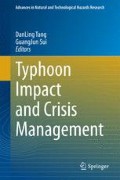Abstract
This chapter presents the economic loss prediction of typhoon by different pattern recognition methods, such as multivariable statistics (MS), case base reasoning (CBR), fuzzy theory (FT), and neural network model (NN). The typhoon records in Taiwan before 2000 were used as the database for reference, and the records after the year 2000 were predicted using the pattern derived from the database. Six scenarios were calculated using these methods. The first sceneries include the parameters: maximum wind speed, minimum atmospheric pressure, maximum wind speed in typhoon center and lowest atmospheric pressure near typhoon center. The second scenario includes the previous four parameters with rainfall and calculated by CBR. The third scenario uses the fuzzy calculation with five parameters. The successful rate of prediction for the three methods was 12.5, 37.5, and 57 %. The results reveal that the fuzzy calculation can significantly increase the prediction rate than the traditional CBR method. On the other hand, five neural network methods were compared, which were back propagation network (BPN), extend neuron networks (ENN), fuzzy neural network (FNN), analysis adjustment synthesis network (AASN), and genetic algorithm neural network (GANN). The result reveals that the BPN is the best choice, because the error is the lowest among the five schemes in this study.
Access this chapter
Tax calculation will be finalised at checkout
Purchases are for personal use only
References
Aamodt, A., Plaza, E.: Case-based reasoning: Foundational issues, methodological variations, and system approaches. Artif. Intell. Commun. 7(1), 39–52 (1994)
Cheetham, W., Goebel, K.: Appliance call center: A successful mixed-initiative case study. Artif. Intell. Mag. 28(2), 89–100 (2007)
Chen, W.K.: A framework for nuclear power plant emergency response system. Nucl. Sci. Technol. 21, 375–378 (2010a)
Chen, W.K.: An approach to pattern recognition by fuzzy category and neural network simulation. Paper presented at proceeding of the 8th international conference on machine learning and cybernetics (ICMLC), Institute of Electrical and Electronics Engineers (IEEE), Systems, Man, and Cybernetics Society (IEEE SMC Society), Qingdao (2010b)
Chen, W.K.: Environmental applications of granular computing and intelligent systems. In: Pedrycz, W., Chen, S.M. (eds.) Granular Computing and Intelligent Systems: Design with Information Granules of Higher Order and Higher Type, vol. 13, pp. 275–301. Springer, Berlin (2011)
Chen, W.K.: Fuzzy forecasting with fractal analysis for the time series of environmental pollution. In: Pedrycz, W., Chen, S.M. (eds.) Time Series Analysis, Modeling and Applications Intelligent Systems, vol. 47, pp. 199–213. Springer, Berlin (2013)
Chen, W.K., Sui, G.J., Tang, D.L.: A fuzzy intelligent decision support system for typhoon disaster management. Paper presented at proceeding of 2011 IEEE international conference on fuzzy systems, Institute of Electrical and Electronics Engineers (IEEE), Taipei (2010a)
Chen, W.K., Sui, G.J., Tang, D.L., Cai, D.L., Wang, J.S.: Study of environmental risk management by multivariable analysis of pattern structure. Paper presented at proceeding of the 4th international conference on management science and engineering management, Chungli (2010b)
Chen, W.K., Sui, G.J., Tang, D.L.: Predicting the economic loss of typhoon by case base reasoning and fuzzy theory. Paper presented at proceeding of 9th international conference on machine learning and cybernetics (ICMLC), Institute of Electrical and Electronics Engineers (IEEE), Systems, Man, and Cybernetics Society (IEEE SMC Society), Guilin (2011)
Jain, A.K., Duin, R.P.W., Mao, J.C.: Statistical Pattern Recognition: A Review. Department of Computer Science and Engineering, Michigan State University, East Lansing (2000)
Lebowitz, M.: Memory-based parsing. Artif. Intell. 21, 363–404 (1983)
Leung, F.H.F., Lam, H.K., Ling, S.H., Tam, P.K.S.: Tuning of the structure and parameters of a neural network using an improved genetic algorithm. IEEE Trans. Neural Networks 14(1), 79–88 (2003)
Schalkoff, R.: Pattern Recognition: Statistical, Structural, and Neural Approaches. Wiley, New York (1992)
Schuermann, J.: Pattern Recognition. Wiley, New York (1996)
Tu, Z.G., Lu, Y.: A robust stochastic genetic algorithm (StGA) for global numerical optimization. IEEE Trans. Evol. Comput. 8(5), 456–470 (2004)
Watson, I., Gardingen, D.: A case-based reasoning system for HVAC sales support on the web. Knowl. Based Syst. J. 12(5–6), 207–214 (1999)
Yeh, I.C.: Modeling chaotic dynamical systems using extended-neuron networks. Neural Parallel Sci. Comput. 5(4), 429–438 (1999a)
Yeh, I.C.: Modeling chaotic two-dimensional mapping with fuzzy-neuron networks. Fuzzy Sets Syst. 105(3), 421–427 (1999b)
Yeh, I.C.: Classification using extended-neuron networks. J. Comput. 14(2), 6–22 (2002)
Yeh, I.C.: Modeling chaotic dynamic systems using analysis-adjustment-synthesis networks. J. Technol. 18(3), 369–376 (2003)
Yeh, I.C.: Classification and function mapping with fuzzy-neuron networks. J. Technol. 14(2), 153–159 (2005)
Zadeh, L.A.: Fuzzy Sets. Inf. Control 8(3), 338–353 (1965)
Acknowledgments
The present research was supported by research project awatded to DL Tang: (1) Guangdong National Science Foundation, China (2010B031900041, 8351030101000002), (2) Natural National Science Foundation of China (31061160190, 40976091, NSFC-RFBR Project-41211120181), (3) Innovation Group Program of State Key Laboratory of Tropical Oceanography (LTOZZ1201).
Author information
Authors and Affiliations
Corresponding author
Editor information
Editors and Affiliations
Rights and permissions
Copyright information
© 2014 Springer-Verlag Berlin Heidelberg
About this chapter
Cite this chapter
Chen, WK., Sui, G., Tang, D. (2014). A Study on Typhoon Risk Prediction by Different Methods of Pattern Recognition. In: Tang, D., Sui, G. (eds) Typhoon Impact and Crisis Management. Advances in Natural and Technological Hazards Research, vol 40. Springer, Berlin, Heidelberg. https://doi.org/10.1007/978-3-642-40695-9_23
Download citation
DOI: https://doi.org/10.1007/978-3-642-40695-9_23
Published:
Publisher Name: Springer, Berlin, Heidelberg
Print ISBN: 978-3-642-40694-2
Online ISBN: 978-3-642-40695-9
eBook Packages: Earth and Environmental ScienceEarth and Environmental Science (R0)

